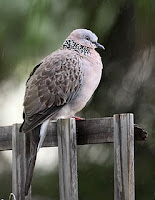 |
| The introduced Spotted Turtle Dove |
A steady trickle of feral Spotted Turtle Dove trapping records continues
to make its way to the Land for Wildlife office. It’s pleasing to see that the
community is continuing to target this avian invader. Recent figures include 50 trapped for the year thus far from a
Garden for Wildlife member in Eastside and 37 in the last three months in LfW
coordinator Jesse’s backyard in Northside.
The bad news is that these high numbers show that the feral
doves are continuing to make Alice Springs a stronghold, displacing native
birds and causing a nuisance as they do so.
 |
| Building dove traps |
If you're not thrilled about the idea of trapping birds, there are more passive methods to deter Spotted Turtle Doves from your backyard. If you have thick shrubbery and vegetation at your place, have a look around for any nesting doves. Turtle doves love to build their nests in dense, non-native vegetation such as palm fronds, rank Bouganvillea thickets and Pepper Trees. By removing such habitat and replacing it with native trees and shrubs, you can transform your garden from a haven for feral pests to a paradise for native birds and wildlife.
 |
| Turtle Dove nest and egg. Photo; J.M. Garg |
Alternatively, if you enjoy the shade your Pepper Tree provides in the hot weather, simply carryout regular 'nest inspections' in likely places. If you find a Turtle Dove nest (a very simple platform of sticks placed on a branch), remove it. Tip out any eggs that might've been laid. After several attempts and constant disturbance, the birds will soon get the message and move elsewhere.
If you find any Turtle Dove nests or eggs, let us know. The information will help us build a picture of where the strongholds of this introduced species are in Alice Springs.

ReplyDeleteFood Safety Auditing
Food Safety Training
HACCP certification
3rd Party Food Audits
Aged Care
FeedSafe Audits
Internal Food Safety Audits
Food Safety Consulting
Food Safety Program Development
You made such an interesting piece to read, giving every subject enlightenment for us to gain knowledge. Thanks for sharing the such information with us to read this......sheds and outdoor buildings
ReplyDeleteAt Mantram Nursing Academy, we offer the top coaching center for PPMET entrance exam preparation. Our experienced faculty provides personalized coaching, structured study plans, and mock exams to help you succeed. With a focus on conceptual clarity and exam techniques, we ensure you’re fully prepared. Join us today and ace your entrance exam!
ReplyDeleteTop Coaching centre for PPMET Entrance exam